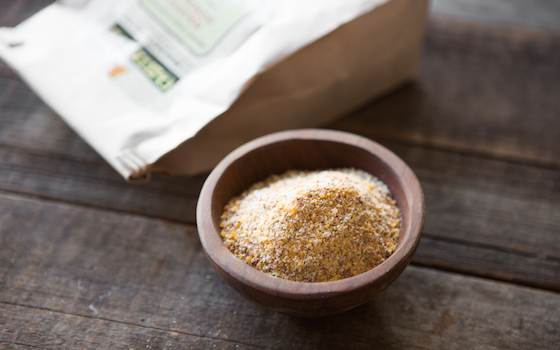When I was asked to write the first blog post for Tino’s Italian Grocery right away I knew I had to share my experience with community grains in Oakland, and more importantly today I want to talk about red flint polenta and its importance on how we as a community view food.
Growing up in a lower middle class family in California polenta was a staple in my family’s home, and rightfully so, it’s inexpensive, quick to cook, and hearty. Polenta has traditionally been a food item for the poor, and unbeknownst to me, the polenta of my childhood had very little resemblance or connection to polenta as it once was before the industrialization of our food system.
So before we get any further I think it is important to talk about what polenta is, and more importantly what polenta is not. Polenta is really a dish, not an ingredient, from northern Italy. It refers to a porridge or mush now made from coarsely ground cornmeal. Corn was cultivated in Europe in the 16th century, but in the past polenta has been made with farro, chestnuts, millet, spelt or chickpeas. Today, polenta is usually made from yellow corn.
Red Flint, “floriani”, Corn Polenta Integrale that we are talking about today is radically different from any polenta or corn meal I have ever experienced, and in my opinion probably the closest example to what polenta was and what it can be. In 2000 Floriani Corn was re-discovered near the town of Trento in Northern Italy in a small garden. It is currently in very limited production in the United States.
Polenta Integrale is the traditional Italian term for “whole milled” meaning the whole kernel is course-milled together with nothing sifted out, offering a beautiful, rustic texture and hearty, full flavor that lends itself as a great accompaniment to ragu’s and braises or alone with butter and cheese.
What really makes this product stand out to me, and why we are so passionate about this polenta in particular at Tinos’s Italian Grocery in Santa Barbara is the fact that this grain is transformative! It makes you think, and evokes an emotional response, so familiar to the polenta we grew up with but so different at the same time. The first time I tasted this polenta at Oliveto’s Restaurant in Oakland, my immediate thought was “what other foods have I been wrong about?” It made me ask the question, if this is polenta, what is a tomato? Or where can I find the best example of a tomato? Is a strawberry just a strawberry or have I been wrong about that all this time too? From that moment years ago to this very moment today I’ve been in search of the very best foods available, and have been lucky enough to be able to use Tino’s as a platform to bring these products to Santa Barbara. Here at Tino’s you will find this red flint polenta and many other items that I have selected through extensive research and travel to show case just what real food is, and what it can be.
In closing, I would like to share a segment from community grain’s website on how they like to prepare their polenta, and challenge you to consider where your food is coming from, and what if any history is behind what you are buying and eating.
“When you acknowledge, as you must, that there is no such thing as perfect food, only the idea of it, then the real purpose of striving toward perfection becomes clear: to make people happy, that is what cooking is all about.” – Thomas Keller
How to Cook our Red Flint Floriani Corn Polenta Integrale
Our heirloom polenta is excellent on its own, as an accompaniment to braised lamb, bolognese, grilled vegetables, or prepare it the way they do at Oliveto Cafe, with chile flakes and a fried egg or taleggio cheese.
We’ve also had good results (and saved some effort!) by cooking the polenta in a slow cooker, so we’ve included those directions here as well. Toss the polenta in before you go to bed, and wake up to a piping hot breakfast, ready to be drizzled with cream or eaten with sausage.
A cooked batch will stay good in the fridge for at least 7 days – make a large batch and have it ready to serve all week!
Ingredients:
Makes 3 cups polenta
- 1 cup Community Grains Organic Red Flint ‘Floriani’ Polenta Integrale
- 3 cups water, more if needed (for slow cooker, use 5 cups)
- Salt
- Butter, cheese, or other seasoning (optional)
Directions:
- Stovetop: Lightly salt the water and bring it to boil. Whisk in the polenta. Lower heat and let simmer, uncovered, for 3 hours. Stir occasionally to prevent sticking. Add water if the polenta starts to get stiff. When the polenta is creamy and tender, it is done. Remove from heat, stir in butter or cheese (if using) and serve.
- Slow Cooker: Whisk together salt, polenta, and water into slow cooker. Cover and cook on high for 30 minutes to an hour, to heat the water. Stir, cover, and set cooker to low for about 6 hours. Stir occasionally if possible. If the polenta gets too stiff, add a bit of hot water. When the polenta is smooth, thick, and tender, it is done. Remove from heat, stir in butter or cheese, and serve.




Leave A Comment
You must be logged in to post a comment.